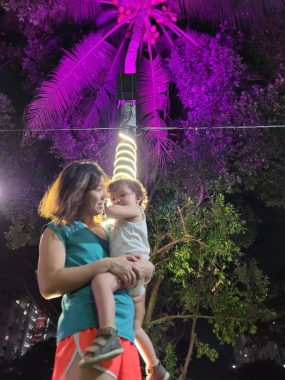How Walking at Night Helps Shed Light on Tomorrow
Evening strolls provide this family important time for reflection

Once Singapore’s warm, tropical sun had set, a cool breeze became noticeable. With only the palm trees swaying above my head, I could think clearly.
I used to reserve this time for high-intensity sports. Now I use it to reflect on the day and plan for tomorrow.
My evening walks began as a way to burn some extra calories once I no longer had time for exercise or hobbies. It may not have been the most intense exercise, but it was relaxing and mentally rewarding.
Eventually, my wife, Judy, and I started walking together. We found that we were able to decrease our stress and prevent depression by having someone to talk to during this light exercise. Many times we brought our daughter, Rylae-Ann, with us. She would nod off to sleep thanks to the rhythmic bumps of her stroller. The therapeutic experience became a part of our routine.

Rylae-Ann and her mother stop to pose under a lit-up palm tree during an evening walk in Singapore, in 2020. (Courtesy of Richard E. Poulin III)
Our walks take on new meaning
When Rylae-Ann was born, I dreamed of getting her into the same types of sports as me so we could have daddy-daughter weekends. That was always my dream, and never hers. Those plans were derailed when she was diagnosed with aromatic l-amino acid decarboxylase (AADC) deficiency, but it was naive to ever think I could plan my daughter’s future for her.
This rare neurotransmitter disease changed our lives forever. While we have fully embraced our new path and make memories every day, making that transition was not easy. Our simple habit of taking walks at night really helped me during this time.
It may seem counterintuitive that walking in darkness helps to keep me free of darkness, but it’s a time when I can be calm and focus my mind.
These peaceful moments don’t have to take place during a walk or at night. Others may achieve the same effect from sitting in a quiet room, taking a shower, or exploring nature. Regardless of location, it’s vital to be free of distractions, so it’s a good idea to ensure you aren’t near any technology.
A time for reflection
The most important element of my walks is that they allow me time and space for reflection.
Reflection is a skill embedded into our curriculum here in Thailand, and is a requirement for both students and educators. Being reflective means thoughtfully considering your environment, ideas, and experiences, and analyzing your strengths and weaknesses. This supports learning and personal improvement.

Rylae-Ann concentrates on her reflection while applying makeup. (Courtesy of Richard E. Poulin III)
Reflection is key in developing a growth mindset, a term coined by American psychologist Carol Dweck. A growth mindset involves viewing negative events as temporary obstacles that can be overcome. A person with this mindset also views intelligence, abilities, and talents as learnable, and believes they can improve their skills through hard work, thoughtful strategies, and feedback.
The opposite is known as a fixed mindset. This is where someone views weaknesses as unchangeable and believes things will remain the way they are.
If you are feeling overwhelmed, or like you’re slipping into a fixed mindset, take a moment to pause. Reflection allows your brain to settle down amid the chaos. As a parent of a child with a rare disease, so much can transpire in a day that it often feels like I didn’t even have a moment to sit down. But spending time untangling and sorting through all of my observations and experiences allows me to focus and consider what’s happened. By doing this, I can better understand the problems I face and make smarter decisions.
Although we moved on from Singapore, and our daughter is in a much better place than when we first began our evening strolls, we continue the tradition here in Thailand, sometimes as a family and sometimes alone.
By spending time reviewing the day and planning for tomorrow, I feel more confident facing new adventures on our journey with AADC deficiency.

In a recent picture, Rylae-Ann and her father take a walk at night to reflect on their day and plan for tomorrow. (Courtesy of Richard E. Poulin III)
Note: AADC News is strictly a news and information website about the disease. It does not provide medical advice, diagnosis, or treatment. This content is not intended to be a substitute for professional medical advice, diagnosis, or treatment. Always seek the advice of your physician or other qualified health provider with any questions you may have regarding a medical condition. Never disregard professional medical advice or delay in seeking it because of something you have read on this website. The opinions expressed in this column are not those of AADC News or its parent company, BioNews, and are intended to spark discussion about issues pertaining to aromatic l-amino acid decarboxylase deficiency.






Comments